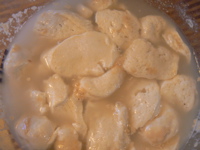
My three-day, rotational, Country White dough...and first attempt at blogging.
I bake this bread every third day or so, and it pretty much always turns out the same. The original recipe is the basic white dough from Richard Bertinet's "Dough", which I absolutely love. I stumbled upon this process one day by accident.
I woke up early one Saturday and decided it was a good day for some fresh bread. After mixing up the dough, and putting it in the oven to rise (I usually use the oven with the light on trick), my wife reminded me that we had to get ready to leave for the day...oops. I slid the dough into an oiled plastic bag, and popped it into the refrigerator.
Well, as we all know, life happens fast. I kept remembering that dough ball in the fridge, but didn't seem to have time to bake it. Finally, a few days later I had the crazy idea to use it like a starter. I have since read that this isn't a crazy idea, but a pretty common one. Now it's become my bread of choice. Every few days I take the bag of dough out of the fridge, chop it into thirds, and make three batches of the original recipe, adding a third of the old dough to each. I've even gone as far as a week and a half between baking, which makes a deliciously sour loaf!
A few days early, mix up this dough and stash it in an oiled bag in the refrigerator:
18 oz white bread flour
12.5 oz water
2 tsp kosher salt
1.5 tsp instant yeast
When you're ready to bake, here's what I do.
First, take your dough out of the refrigerator, and divide it by weight into three equal portions. Take one portion, and cut it up into little strips or balls about an 1x1 inches. The smaller it is, the easier it is to mix into the dough. Measure out your water. If the dough is really cold, I use pretty warm water. Plop your old dough into the water and let it hang out while you measure out your other ingredients. You end up making the recipe three times, so I like to get all the old dough in separate water portions, with three bowls of dry ingredients ready, too.

I pour the first batch of water / old dough into the Kitchenaid bowl with the paddle attachment, and mix on low for a few minutes until it's pretty well homogeneous.
I mix the flour, salt, and yeast in a bowl by swirling it with the dough hook by hand.
Next, I pour the dry mixture on top, replace attachments with the dough hook, and turn the machine on to level 2 for two minutes. If it doesn't seem to be picking up the flour as well as I like, sometimes I stop the machine, and scrape the bowl with the hook a few times.
After two minutes, I turn the machine up to level four for seven minutes. Notice it's a nice, wet dough.

I turn the dough straight out onto a floured surface, and tri-fold it into a ball. I put this in a floured bowl, and place in the oven until risen double.

After the first rise, I gently pull it into a square, and tri fold it again. I put it back in the bowl, and rise it in the oven for a second time.

After this rise, I square it, and form the final loaf. I put it on a floured tea-towel. I put a 12 inch dutch oven, with lid in the oven and preheat it to 525F
Pretty much by the time the oven is pre-heated, I take the dutch oven out and set it on a cutting board. I flop the dough into it, put the lid on, and put it back in the oven for 20 minutes.
After 20 minutes, I remove the lid and bake for 15 more minutes, or until it's nice and golden brown.

Now, just do it again. The third batch I bag up and save in the refrigerator for next time.

This bread makes really yummy, crispy toast. We ate it just this afternoon as chicken salad sandwiches. It's our all-purpose bread.












